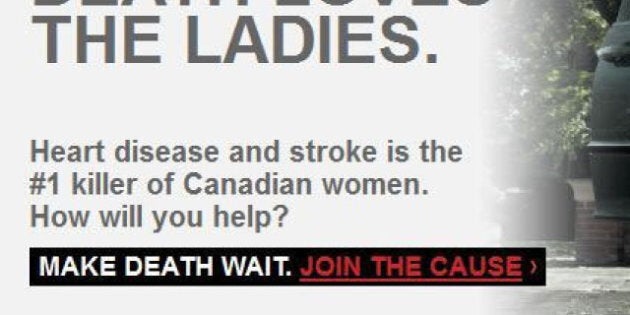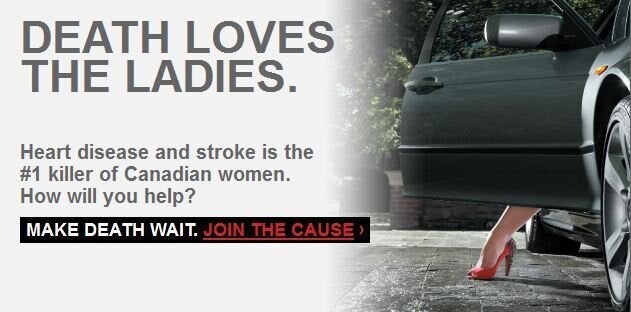
When you're a non-profit trying to raise awareness of a major health issue, it makes sense to think outside the box.
That's the approach the Heart and Stroke Foundation has taken in its new "Make Death Wait" ad campaign. The TV portion of the campaign consists of two ad spots, one designed to announce the statistic that one in three people will die of heart disease, and another targeted at women to help them realize that heart disease is the number one killer of women.
The ad for women features a male voiceover that says, "I love women. I love older women, professional women..." over various images of women: a long shot of a woman by a pool, a younger woman running with her child in a stroller, an older woman dancing with her husband.
At the end of the ad, a female voice encourages us to "Make Death Wait," to donate, and lets us know the stat about women's risk for heart disease. It's an edgy ad that is likely to get noticed and provoke a variety of reactions.
My reaction was to feel unsettled. I felt the distanced visuals made the disembodied male voice sound like a stalker. One of the images on the Heart and Stroke Foundation's website reads: "Death Loves the Ladies" only reinforced the creepy feeling for me.

Courtesy of Heart and Stroke Foundation.
But I know how important the issue is, so I wanted to see what others' reactions were. I put the link to the ad up on Twitter and Facebook with no comment about my own opinion and asked people what they thought.
Turns out I wasn't the only one who found the ad off-putting. One Twitter follower said, "[It's] like they had a good idea at first (conversation about women's risk) but degenerated into awful stalker ad." She continued, "Also showed it to 2 female co-workers, neither of whom identify as strong feminists. Both hated it - stalker, rapist, creepy."
A Facebook commenter replied, "Making death sound like a creepy humanized stalker? No thanks."
"This gives the impression that the weird voyeur is eventually going to catch us. I cannot stress enough how uncomfortable that made me feel," said another.
In addition, some commenters expressed concern that the ad stereotypes women by implying all women put their husbands and families first: "It reinforces the idea that women always put themselves last, and it also makes very heteronormative assumptions about women's lives. What about single women, lesbians, those who may be partnered but not married, and so on?" asked a woman from Edmonton.
Though most of the commenters weren't people I knew, I realize an informal survey of my social networks is not a scientific measure of public reaction. I also think the reaction could be generational, since the older women in my office tended to love the ad, conceding they felt it was creepy but necessary to get people to realize the importance of the issue. They felt it grabbed their attention and made them want to take action.
To better understand the ad's goals, I spoke with Lisa Chicules, the vice president of marketing and communications for the Heart and Stroke Foundation. She said it was important for the Heart and Stroke Foundation to put out something that would grab attention because of how unrecognized women's risk is.
"We wanted to make sure we were getting a message out to Canadians about the risk factors around heart disease and stroke. People felt risk wasn't urgent and relevant. There was a perception versus reality issue and we needed to close that gap," she said.
I asked her about some of the concerns I had with the ad, specifically the stalker factor. She said she had never heard that concern expressed and that it didn't worry the organization.
"It was more about creating concern around the issue. More just to recognize you're at risk. You have to use a powerful tool or it won't be noticed. If we just came out and told women in a matter-of-fact way it doesn't have the same impact in terms of capturing their attention," Chicules said.
Chicules emphasized that the final ad and a range of other versions had gone through extensive testing to measure impact. The one that's currently airing was deemed to be the most effective.
"I think part of it is to remember that our goal was to drive home the urgency of these diseases and we had to do it in a way that was powerful and impactful. Our research showed almost 50 per cent of women don't know the fact and realize they're at risk for heart disease. It should be 100 per cent. People don't talk about it," Chicules pointed out.
Regardless of people's reaction to the ad, it looks like it will be sure to get people thinking more about the issue. I asked Chicules what women should do if they're concerned about their risk for heart disease.
"I'm hoping women will say, 'Oh my gosh, I had no idea I was at risk and I should do something about it.' And the 'do something' could be a variety of things -- go online and do a risk assessment, talk to your doctor, look for health information. And of course if you wanted to you could also donate," she concluded.